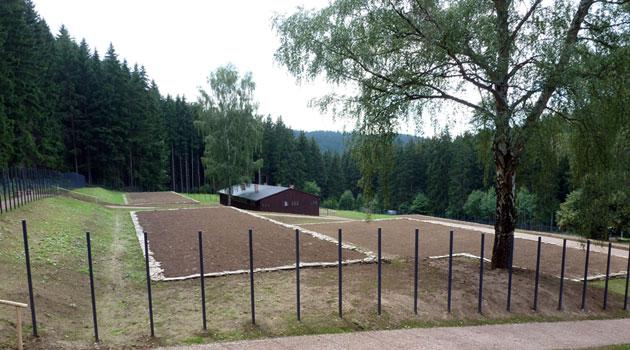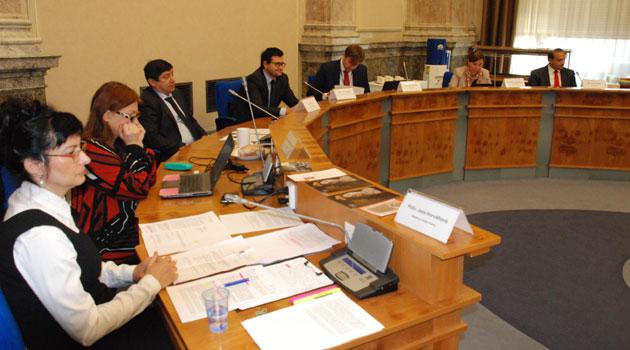Czech Govt Council on Roma Affairs insists Museum of Romani Culture manage Romani Holocaust memorial at Hodonín

The Czech Government Council on Roma Minority Affairs is insisting that the memorial to Romani Holocaust victims at Hodonín u Kunštátu be transferred into the administration of the Museum of Romani Culture in Brno. The council has also expressed its disagreement with removing the term “Romani” from the name of the memorial.
The council passed a resolution embodying these points at its session on Friday, 17 February. News server Romea.cz was informed about the meeting by the civil society members of the council and by Jiří Souček of the Governmet’s press department.
Discussion of various points about the administration of the memorial to the Romani victims of the Holocaust at Hodonín sparked emotional discussion at the Friday session. The memorial currently is managed by the Czech Ministry of Education, Youth and Sport, which has tasked the J.A. Comenius National Pedagogical Museum and Library (NPMK) with administering it.
The memorial should open to the public this summer. Civil society members of the council expressed surprise that the Government had begun to consider leaving administration of the memorial with the NPMK.
Discussion was held about the name of the memorial, and one option proposed was for it to be called the “Hodonín Memorial” instead of the originally planned name, “Memorial to the Romani Holocaust at Hodonín u Kunštátu”. “A 2011 Government decree says the entire name of the newly-created memorial is to be the ‘Memorial to the Romani Holocaust at Hodonín u Kunštátu’. Therefore we reject the plan to remove the phrase ‘Romani Holocaust’ from the name of the memorial,” said Jan Balog, vice- chair of the civil society section of the council.
Both this council and its previous incarnation have repeatedly recommended the Government transfer administration of the memorial to the Czech Culture Ministry and its directly-funded organization, the Museum of Romani Culture. Doing so was also one of the measures contained in the Romani Integration Strategy to 2020, which the Government approved.
“Our Romani victims are resting there, and it is therefore natural that the administration of the memorial and the place of remembrance belong to Romani insitutions,” Balog said. The council eventually adopted a plan to transfer the memorial to the Museum of Romani Culture.
Civil society members of the council emphasized that the topic of the Romani victims of the Holocaust is all but unknown to the Czech public, and therefore the name of the memorial should correspond to its theme. The council also unanimously agreed that it is essential that the Romani community administer memorials to the Romani Holocaust and called on the Czech state to make it possible for them to administer sites where Romani people have died, just as representatives of the Jewish community have been permitted to do for many years.
Czech Human Rights and Legislation Minister Jan Chvojka (Czech Social Democratic Party – ČSSD) promised that a bill to transfer the memorial to the Culture Ministry and to assign its administration to the Museum of Romani Culture would be prepared by the end of May. He will work on that with Czech Culture Minister Daniel Herman (Christian Democrats – KDU-ČSL) and with Czech Education Minister Kateřina Valachová (ČSSD).
History of the building of the Memorial since 2009
2009 – On the basis of Government Decree No. 589 dated 4 May 2009, funds were allocated to the Czech Education Ministry in 2009 to buy the land and implement the project. The memorial was to be built at the site of the former recreation center that replaced the former concentration camp in Hodonín (Blansko district).
2012 – The Czech Education Ministry transferred the land to the J.A. Comenius National Pedagogical Museum and Library (NPMK), a directly-funded organization established by the ministry, and construction work began at the site. After an archeological survey was performed, the NPMK reconstructed one of the preserved prisoners’ barracks. The result is a building that faithfully resembles the form of one of the barracks from the time during which the so-called “gypsy camp” existed there, i.e., 1942-1943.
2013 – NPMK organized a student competition to design the rest of the Memorial for students at Czech college architecture departments and as many as 90 students submitted 30 proposals. The winning design by Richard Pozdníček was realized in 2015─2016 by a team of planners lead by Petr Labonek, under the technical supervision of Radoslav Hošek of the PORR company.
2016 – In the summer the construction work on the memorial ended after five years. The director of the NPMK, Markéta Pánková, outlined at a press conference what the exhibition at the memorial will look like. She said the memorial will be reminiscent of the internment camp for Moravian Roma during the Second World War that ran there and that it had also been used as an internment center for Germans who were expelled from the country after the war and then served as a forced labor camp during the 1950s.
The total cost of buying the land, creating the exhibition and reconstructing the site was CZK 98 million [EUR 3.6 million]. Of that, it cost CZK 20 million to buy the recreation area from its private owner, while CZK 78 million was spent to build or reconstruct the architecture and create the exhibition.
